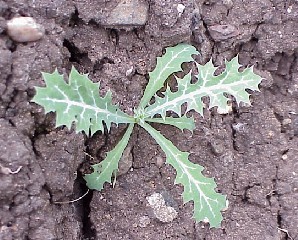Scientific name: Argemone ochroleuca Sweet
Common name: Mexican poppy, prickly poppyFamily: PapaveraceaeHabit:Annual herb initially forming a rosette, then growing with upright stems to 1 m in height. Habitat:A weed of untended areas such as roadsides, railway lines, sandy stream beds and alluvial flats. Also found in recently cultivated paddocks. General description:Stems and leavesThe pithy stems are conspicuously bluish-green (glaucous) and upright. Leaves are initially arranged in a rosette and then are alternately arranged on upright stems that develop as the plant matures. The leaves are also very glaucous and are sometimes variegated in appearance. They are deeply divided (pinnatifid) with sharp prickles on the margins. Stems and leaves exude a yellowish sap when broken. Flowers and fruitsThe flower buds are oblong and 8-18 x 4 x 11 mm in size. Flowers are 3-7 cm across with six pale yellow or lemon petals. They have numerous stamens (20-75) and a purple stigma with spreading lobes exposing blue-green coloured surfaces between them. Flowering usually occurs during spring and summer. The fruit are capsules and are narrowly egg-shaped (ovoid) or ellipsoid (2-5 cm x 1-1.8 cm in size). They are spiny and may have some large recurved spines. The fruit split from the apex downward when mature. Seeds are black/brown, almost round (1.5 mm in diameter) and can be poisonous. Distinguishing characteristics:Annual herb developing a rosette of deeply-divided, blue-green (glaucous), leaves with sharply toothed and prickled margins. Later growing upright leafy stems which bear pale yellow six-petalled poppy flowers. There are two species with the common name of Mexican poppy. Argomone ochroleuca, which is much more common, can be differentiated from Argemone mexicana by:
|
Brisbane
St Lucia, QLD 4072
+61 7 3365 1111
© 2009 The University of Queensland

